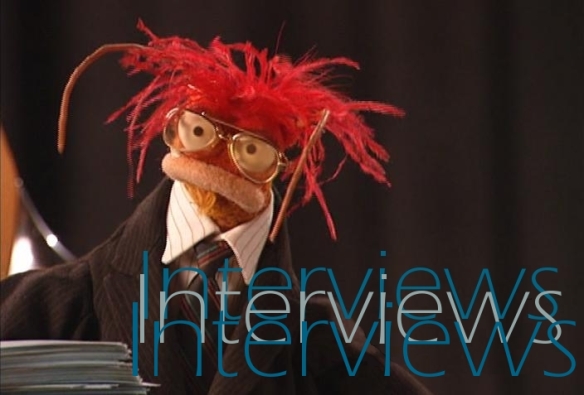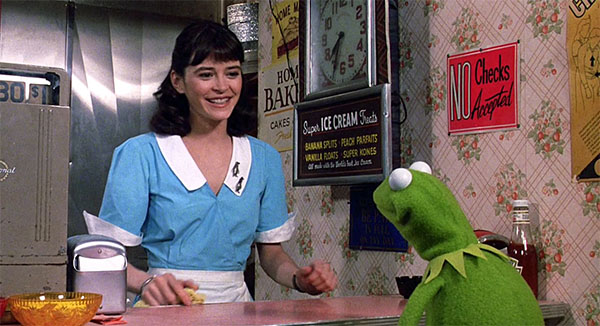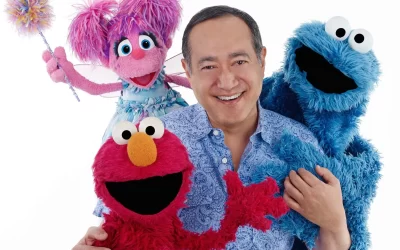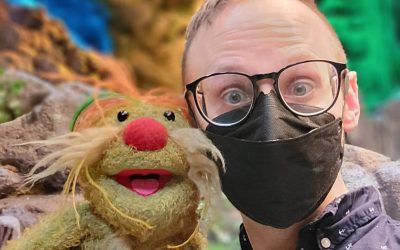 Today I am thrilled, honored, and proud to present the first part of our four part interview with the man, the myth, the whatever: Dave Goelz. For those who don’t know, Dave has been an integral Muppet performer for over 35 years, originating unforgettable and irreplaceable characters including Gonzo the Great, Dr. Bunsen Honeydew, Boober Fraggle, Uncle Traveling Matt, and countless more. It is a true honor to welcome Dave to The Muppet Mindset for an interview and I truly cannot thank him enough for answering my questions. He is truly hysterical, wonderful, and the best in the business.
Today I am thrilled, honored, and proud to present the first part of our four part interview with the man, the myth, the whatever: Dave Goelz. For those who don’t know, Dave has been an integral Muppet performer for over 35 years, originating unforgettable and irreplaceable characters including Gonzo the Great, Dr. Bunsen Honeydew, Boober Fraggle, Uncle Traveling Matt, and countless more. It is a true honor to welcome Dave to The Muppet Mindset for an interview and I truly cannot thank him enough for answering my questions. He is truly hysterical, wonderful, and the best in the business.
Read Part 2, Part 3, and Part 4.
Interview with Dave Goelz
Conducted by Ryan Dosier
Dave Goelz’s Answers © Dave Goelz 2013
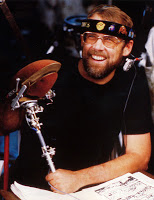 RYAN DOSIER: We at The Muppet Mindset are extremely thrilled and honored today to welcome a true Muppet legend for an interview: Dave Goelz! First of all, Dave, welcome to The Muppet Mindset. Make yourself at home, don’t mind the mess—it’s always there. If I find anything edible, can I offer it to you?
RYAN DOSIER: We at The Muppet Mindset are extremely thrilled and honored today to welcome a true Muppet legend for an interview: Dave Goelz! First of all, Dave, welcome to The Muppet Mindset. Make yourself at home, don’t mind the mess—it’s always there. If I find anything edible, can I offer it to you?
DAVE GOELZ: Ryan, you know very well we are not in the same room. This is being done by email. Jeez, can we just try to keep it real?
RYAN: Well the people didn’t come to read small talk (I don’t think), so why don’t we get things started? How did you meet Jim Henson?
 DAVE: I met Frank Oz first, at a Puppeteers of America conference in Oakland, CA. He was gracious enough to allow me to visit the Sesame Street set a month later. I spent a week there, watching them shoot. Caroll Spinney kindly took me to lunch. When I showed him the puppets I had built, he suggested I meet Bonnie Erickson, who ran the Muppet Workshop. She took a look at my puppets and suggested that Jim and I meet, which happened a couple months later on his next trip to California.
DAVE: I met Frank Oz first, at a Puppeteers of America conference in Oakland, CA. He was gracious enough to allow me to visit the Sesame Street set a month later. I spent a week there, watching them shoot. Caroll Spinney kindly took me to lunch. When I showed him the puppets I had built, he suggested I meet Bonnie Erickson, who ran the Muppet Workshop. She took a look at my puppets and suggested that Jim and I meet, which happened a couple months later on his next trip to California.
RYAN: You started off as a puppet builder but quickly rose through the ranks and became one of the main Muppeteers. How did this come about? What did this show you about Jim’s belief in people?
DAVE: I just moved laterally from designing/building into performing. During the first season of the Muppet Show I did both jobs.
 I showed Jim my industrial design portfolio to illustrate how I might be useful to him. The last three items were puppets that I had recently built. I told him that I was interested in puppeteering. Jim said they already had three star performers, but that if I were to join as a designer/builder, he would work with me and use me as an extra puppeteer in specials. Within a few months I joined the Muppet Workshop, and true to his word, Jim came by with Frank Oz after work twice that summer to teach me the Muppet performing style. Also true to his word, Jim offered me three parts to play when the Muppet Valentine Special came along a few months later. Though Jim wanted me to stay with the company, at the time I preferred California to New York, so I went home and started my own puppet business, doing trade shows and industrial videos. My business was successful, and within a few months Jim offered me the chance to return to Muppets and also maintain my primary client. I would relocate to New York, but have several trips back to California and other locations each year to service my client. At the same time, my client would now have a direct association with the Muppets, and the assurance that another Muppet performer would be provided if for any reason I were unable to service them. In addition to performing, I was functioning as a producer and director for my client––getting lots of valuable experience doing business, writing, working with songwriters and recording studios. On a small scale, I was doing all the things that Jim was doing in his company. It was a total win-win for everyone involved.
I showed Jim my industrial design portfolio to illustrate how I might be useful to him. The last three items were puppets that I had recently built. I told him that I was interested in puppeteering. Jim said they already had three star performers, but that if I were to join as a designer/builder, he would work with me and use me as an extra puppeteer in specials. Within a few months I joined the Muppet Workshop, and true to his word, Jim came by with Frank Oz after work twice that summer to teach me the Muppet performing style. Also true to his word, Jim offered me three parts to play when the Muppet Valentine Special came along a few months later. Though Jim wanted me to stay with the company, at the time I preferred California to New York, so I went home and started my own puppet business, doing trade shows and industrial videos. My business was successful, and within a few months Jim offered me the chance to return to Muppets and also maintain my primary client. I would relocate to New York, but have several trips back to California and other locations each year to service my client. At the same time, my client would now have a direct association with the Muppets, and the assurance that another Muppet performer would be provided if for any reason I were unable to service them. In addition to performing, I was functioning as a producer and director for my client––getting lots of valuable experience doing business, writing, working with songwriters and recording studios. On a small scale, I was doing all the things that Jim was doing in his company. It was a total win-win for everyone involved.
RYAN: Your first major character was, obviously, Gonzo. Did Jim provide any advice on making Gonzo explode (probably literally) from a secondary character to one of the most popular Muppets?
 DAVE: During the first season, Jim and Frank encouraged me to develop the manic side of Gonzo’s personality, along with his insane certainty that he was a genius. Two things stood in my way: lack of confidence and the fact that Gonzo’s downcast eyes looked sad and defeated. I’ve told the story too many times, so I’ll just say that during the first season of The Muppet Show I got exactly one laugh from the crew, and it occurred when I allowed Gonzo to overreact strongly. That convinced me that it could be funny when Gonzo got excited, but the problem was he could not look excited. So I asked Jim if I could build a new Gonzo between the first and second seasons whose eyes could open wide. Jim agreed, I did it, and the next season I got another laugh from the crew. There was no stopping me now.
DAVE: During the first season, Jim and Frank encouraged me to develop the manic side of Gonzo’s personality, along with his insane certainty that he was a genius. Two things stood in my way: lack of confidence and the fact that Gonzo’s downcast eyes looked sad and defeated. I’ve told the story too many times, so I’ll just say that during the first season of The Muppet Show I got exactly one laugh from the crew, and it occurred when I allowed Gonzo to overreact strongly. That convinced me that it could be funny when Gonzo got excited, but the problem was he could not look excited. So I asked Jim if I could build a new Gonzo between the first and second seasons whose eyes could open wide. Jim agreed, I did it, and the next season I got another laugh from the crew. There was no stopping me now.
Another pivotal moment came during an episode where Gonzo had to interview real dancing chickens to use in his act. The animal trainer promised the chickens would dance, but after three weeks in training, they flatly refused. I had Gonzo ask one of the chicks to “do a little two-step,” and the chicken walked out the door. Gonzo said “Don’t call us, we’ll call you,” then turned to camera and said “nice legs, though.” That cracked Jim up, and thus began Gonzo’s fascination with poultry.
RYAN: Who were some of your favorite guest stars on the show that you got to work with? Who were some of Gonzo’s favorites?
 DAVE: I was amazed by what the guests could do. For me, straight off the street, it was a revelation of how entertainment was made of air. The shows were made out of nothing… just ideas fleshed out by characters, foam, fabric, sets, music and a lot of talent and hard work.
DAVE: I was amazed by what the guests could do. For me, straight off the street, it was a revelation of how entertainment was made of air. The shows were made out of nothing… just ideas fleshed out by characters, foam, fabric, sets, music and a lot of talent and hard work.
Of course there were a lot of unforgettable moments, some of which included: Peter Sellars, John Cleese, Paul Simon, Jonathan Winters, Edgar Bergen, Senor Wences, Blondie and Carol Burnett. There were dinners with Peter Sellers, Jonathan Winters, and Roy Rogers––who reminded me of my dad, and he was just the greatest guy. There are many, many other sparkling memories. If I don’t stop we’ll have to build a server farm.
RYAN: You often got to test your singing chops on the show as well, especially as Gonzo. What songs were some of your favorite?
 DAVE: I have no singing voice of my own, but I can sort of manage in character. If I auditioned for American Idol as myself, they would definitely use my audition––only in one episode, of course. They would just slaughter me. That’s how bad I am. But as a character, I can hold my own.
DAVE: I have no singing voice of my own, but I can sort of manage in character. If I auditioned for American Idol as myself, they would definitely use my audition––only in one episode, of course. They would just slaughter me. That’s how bad I am. But as a character, I can hold my own.
So it has been an honor, in a Walter Mitty way, to spend thousands of hours working in recording studios. It’s really fun.
But you asked about songs. Again, I could go on for a long time, but I can think of several off the top of my head that I love: “I’m Going to Go Back There Someday,” which Paul Williams wrote for Gonzo for The Muppet Movie. “When the River Meets the Sea,” written by Paul for Emmet Otter’s Jug Band Christmas, is heartbreakingly gorgeous. I’d include everything written for Fraggle Rock by Dennis Lee and Phil Balsam. Those two were an astonishing team. Barry Mann and Cynthia Weill wrote Professional Pirate for “Muppet Treasure Island” (along with half the hits I grew up with). These writers are all geniuses, and I can hardly believe I’ve had the privilege of working with them. I’ve sung on hundreds, if not thousands, of recordings. If you are a song and I have left you out, please forgive me.
RYAN: You, of course, perform Dr. Bunsen Honeydew, head of Muppet Labs. Of all the useful inventions you showed off over the years, which one do you think would actually be profitable or practical?
DAVE: That’s an internal reality question. I can’t answer those.
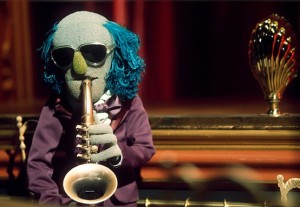 RYAN: And you also perform Zoot, both awake and asleep. With the Electric Mayhem you got to rock out on many great numbers. Are there any favorites that stand out?
RYAN: And you also perform Zoot, both awake and asleep. With the Electric Mayhem you got to rock out on many great numbers. Are there any favorites that stand out?
DAVE: Here are some: “Your Mama Won’t Like Me,” the Suzi Quatro song sung by Jim as Dr. Teeth, “New York State of Mind,” sung by Jerry Nelson as Floyd, “Fever,” performed by Rita Moreno and Animal, “Can You Picture That?” from The Muppet Movie. Oh, and “Sax and Triangle,” with me performing Zoot.
RYAN: As Beauregard you got to be… well, dumb, but at the same time very endearing and loyal. What is your favorite aspect of Beauregard’s character?
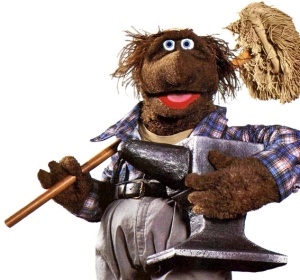 DAVE: I like his unquestioning loyalty. It’s endearing when we see that in horses and dogs. They just trust us and go along with us. They put their lives in our hands. You feel protective of them. I feel that way about Bo. See? I even spell it the way he does.
DAVE: I like his unquestioning loyalty. It’s endearing when we see that in horses and dogs. They just trust us and go along with us. They put their lives in our hands. You feel protective of them. I feel that way about Bo. See? I even spell it the way he does.
RYAN: Like Kermit, Jim had an incredible knack of seeing the talent in people and attracting a wonderful group of crazies to work with him. Can you talk about how this affected the work environment and the way Jim interacted with his fellow makers of entertainment?
DAVE: That is the essence of the Muppets. The Muppet Show character group is just like the company that Jim gathered together. Jim relished life; he felt like part of everything. And he appreciated all sorts of people. Jim was rare in that while he was an astute judge of character, he carried almost no prejudices. He almost always found something to like about a person. That was a great lesson for me. Through my association with Jim, I have been enriched by friendships from many different cultures around the world.
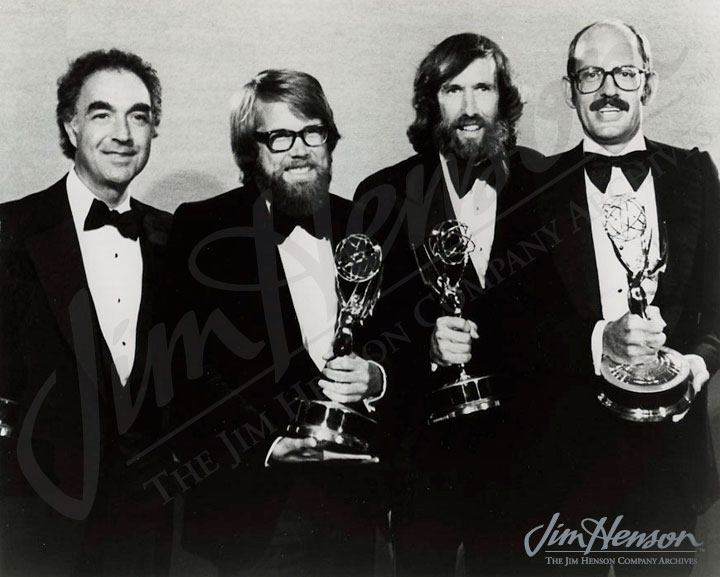 I had come from Silicone Valley, where the workforce was kind of homogeneous. At Jim Henson Productions there were all sorts of personality types. It occurred to me that many of these folks would not be employable in the world I had just left. But Jim not only gave them jobs, he treasured them. That love of diversity is woven into the Muppet character world.
I had come from Silicone Valley, where the workforce was kind of homogeneous. At Jim Henson Productions there were all sorts of personality types. It occurred to me that many of these folks would not be employable in the world I had just left. But Jim not only gave them jobs, he treasured them. That love of diversity is woven into the Muppet character world.
RYAN: You’ve often been quoted about your stories of the encouraged upstaging atmosphere on the set of The Muppet Show and other projects Jim helmed. Can you talk a little bit more about this?
DAVE: “Helmed?” So you read the Hollywood Reporter.
Jim loved to laugh. He was generous. He enjoyed it when others shone. He appreciated their work. He loved surprises. He loved ambushes. And he established his own company culture that accommodated these things.
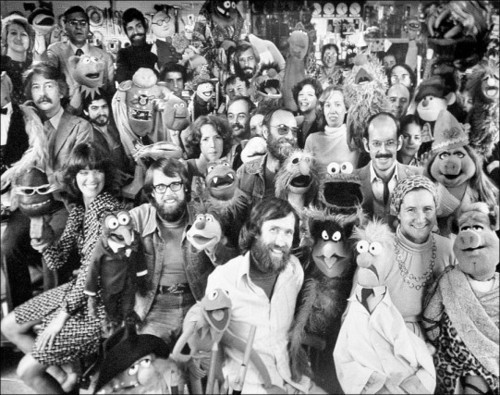 Now, can you imagine a more fun boss than that? So we relished playing tricks on each other. These consisted of scares, ambushes, explosions, fish heads in the toilet, monsters in the closet, fake mice that made you jump and ran straight under you, real mice that ran around the workshop on elevated tramways made of Slinky Toys, video pranks, and, of course, upstaging. Our work usually includes lots of layers, and there’s nothing more fun than watching a scene for the third time and discovering a juicy little tidbit of upstaging. Before Steve Whitmire had any characters on the Muppet Show, he spent many backstage scenes performing a nondescript rat by himself up on the balcony. He invented business, often developing his own narrative that was quite separate from the string of backstage scenes in an episode. He was learning. Jim loved it and appreciated it. The rat became Rizzo. And later, Steve became Kermit. Jim’s permissiveness was an act of creation.
Now, can you imagine a more fun boss than that? So we relished playing tricks on each other. These consisted of scares, ambushes, explosions, fish heads in the toilet, monsters in the closet, fake mice that made you jump and ran straight under you, real mice that ran around the workshop on elevated tramways made of Slinky Toys, video pranks, and, of course, upstaging. Our work usually includes lots of layers, and there’s nothing more fun than watching a scene for the third time and discovering a juicy little tidbit of upstaging. Before Steve Whitmire had any characters on the Muppet Show, he spent many backstage scenes performing a nondescript rat by himself up on the balcony. He invented business, often developing his own narrative that was quite separate from the string of backstage scenes in an episode. He was learning. Jim loved it and appreciated it. The rat became Rizzo. And later, Steve became Kermit. Jim’s permissiveness was an act of creation.
RYAN: What were some of your favorite moments from The Muppet Show when you got to work close to Jim?
 DAVE: Here’s one you would never know about: The Gills Brothers (a fish barbershop quartet) sang a song. Jim asked me to work out choreography for the number. I did this, and taught it to the other puppeteers, one of whom was Jim. At the end of the song, I had the fish keel over out of sight. Jim said “what kind of ending is that?” Well, choreographers invent names for moves, so I said “this the ‘die’ ending. The fish just keel over.’’ Jim said “you can’t do a ‘die ending!’” We got into a mock argument about the ‘die ending.’ We went back and forth with me claiming it was a genius invention, and Jim responding that it was idiotic. “That’s a stupid ending. We can’t do a ‘die ending.’ That’s just stupid!” I kept insisting that its very stupidity was exactly why it was so cutting edge. We went on and on, and of course we did not do the “die ending.” But we had a lot of fun pretending to argue about it.
DAVE: Here’s one you would never know about: The Gills Brothers (a fish barbershop quartet) sang a song. Jim asked me to work out choreography for the number. I did this, and taught it to the other puppeteers, one of whom was Jim. At the end of the song, I had the fish keel over out of sight. Jim said “what kind of ending is that?” Well, choreographers invent names for moves, so I said “this the ‘die’ ending. The fish just keel over.’’ Jim said “you can’t do a ‘die ending!’” We got into a mock argument about the ‘die ending.’ We went back and forth with me claiming it was a genius invention, and Jim responding that it was idiotic. “That’s a stupid ending. We can’t do a ‘die ending.’ That’s just stupid!” I kept insisting that its very stupidity was exactly why it was so cutting edge. We went on and on, and of course we did not do the “die ending.” But we had a lot of fun pretending to argue about it.
RYAN: What are some of your favorite characters on the show other than your own?
DAVE: There are many, but here’s a partial list:
 On The Muppet Show I adore Fozzie. Of course I love Kermit. Others are Floyd, Animal, Dr. Teeth and Janice. Frank’s Marvin Suggs just puts me away. Then there’s Bobo the Bear, Pepe the King Prawn and Howard Tubman.
On The Muppet Show I adore Fozzie. Of course I love Kermit. Others are Floyd, Animal, Dr. Teeth and Janice. Frank’s Marvin Suggs just puts me away. Then there’s Bobo the Bear, Pepe the King Prawn and Howard Tubman.
On Fraggle Rock I love Gobo, Wembley, The Storyteller, Junior Gorg, The Architect, Gunge (Richard Hunt’s rodent shill for the Trash Heap).
Jerry Nelson created many, many one-shot characters that were just brilliant. He did it on every project he was involved with. I wouldn’t know where to begin. Well, we could start with Blind Pew from The Muppet Treasure Island. On Jim Henson’s Secret Life of Toys, Jerry performed Balthazar, a sweet old teddy bear. It just goes on and on.
A new favorite is Lips, the trumpet player. Steve Whitmire has been frustrated that for thirty years he hasn’t really found a character hook for Lips the trumpet player. Just last winter he had to say the line “but we don’t have any instruments.” In a gravelly voice, Steve came out with “Buh we don’ got no insuh-menz.” And the character was born after 30-odd years in labor. I love Lips, and am waiting raptly for his next line.
That’s what keeps it fun.

